Norway
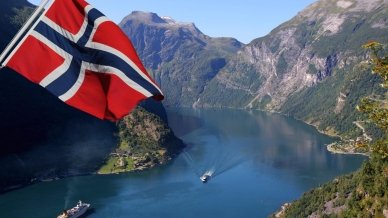
This small country in western Scandinavia is the harsh land of fjords, cold northern rivers, snows, and endless ski pistes.
Its residents have got used to peace and comfort as their homeland has conquered top positions in all possible ratings of life quality. They work much, earn a lot, and as a result, spend much too.
Though spending a holiday in Norway is not cheap, its level is a value for money.

General Information
Norway, as the majority of Scandinavian countries, is a kingdom. It occupies the western part of the peninsula, but that is not its only territory. Spitsbergen archipelago, several islands in the Arctic Ocean, and one overseas territory — Bouvet Island in the South Atlantic Ocean — also belong to Norway.
Historical Background
As a modern country, Norway appeared on the world map in 1905 after gaining independence from Sweden. The official year of its foundation is 1899.
Almost the entire history of Norway is inextricably connected with its closest neighbours — Denmark and Sweden. That connection was so strong that the Kingdom of Norway was a part of the Kalmar Union (three Scandinavian kingdoms under the rule of Danish monarchs) for a couple of centuries in a row. Norway could get only an extended autonomy but not complete independence. The Union existed from 1397 to 1523 and then dissolved when Sweden seceded.
Norway remained the Danish province for the following 300 years. At the beginning of the 19th century, it was annexed to Sweden. After that, the confrontation of Swedish and Norwegian kings and their governments in the fight for state power continued.
The Swedish monarch rejected even the very idea of separation of Swedish and Norwegian flags three times. However, in May 1905, Norway eventually achieved its centuries-long aim: its Storting (Parliament) approved the unilateral secession from the Union.
The referendum of August 1905 finalised that centuries-long, dramatic fight for independence. More than 300,000 Norwegians said “yes” to a new and liberated country. There were only 161 people who voted against it.
Though initially there were attempts to make Norway a country with the republican model of government, monarchy remained. Haakon VII from the House of Glücksburg became the King and reigned till 1957.
His successor was his son Olav V. Since 1991, Harald V has been the King of Norway.
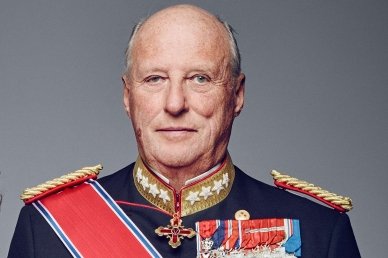
King Harald V of Norway
Geography and Climate
The Kingdom of Norway borders three countries — Sweden, Denmark, and the Russian Federation, three seas — Norwegian, North, and Barents, and one ocean — Arctic.
Mountains and fjords make the most of the country’s terrain. There are almost no fertile lands, but due to the enormous effort of farmers, Norway can provide itself with the necessary products for 50%, and the other half stems from imports.
The main way of generating the national budget in one of the most developed countries in the world is gas and oil extraction. The second position is occupied by chemical engineering, and the third — by fishing and fish-processing plants. Norwegian canned fish is highly appreciated around the world.
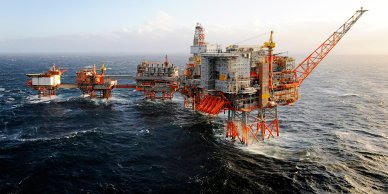
Valhall oil field in the Norwegian sector of the North Sea.
Climate is versatile though this northern country might seem very cold all year round.
In reality, Norwegian summer is usually hot. Day temperatures reach +25°C - +28°C, water heats to +19°C. There is a multitude of those willing to swim as Norwegians are not afraid of such temperatures.
Spring here begins in March and ends in May. Nature awakens slower than in the other part of Europe, but greenery fascinates in the same way. The barbecue season begins, which is the favourite activity of Norwegians during weekends. People gather in big groups and go on picnics, have fun, eat a lot of food and drink a lot of various beverages.
Norwegian winter is a perfect season for those indifferent to active leisure. Ski and snowboarding pistes, ice rinks, and mountaineering activities are awaiting their fans from November to February when the weather is frosty and snowy.
The geographical location of this Scandinavian country enables its citizens to enjoy two unique natural phenomena at once — the midnight sun and aurora polaris.

Northern Lights in Norway
The midnight sun usually lasts from June to the beginning of August. The best place to spectate the wonder is the north of Norway.
The second incredibly beautiful and unusual spectacle is aurora polaris. It can be seen in transpolar regions of the country from the end of September till the end of March. It is the time of early dusk and late dawn when nature shows a true carnival of colours with breathtaking fireworks.
Language, Population, and Currency
Norway is a country with 5,4 population and one official language in two forms. There is not any city with a million-plus population. The biggest one is Oslo (673,000 people), Bergen (around 300,000 people), and Trondheim (around 200,000 people).
The Norwegian language exists in two forms: Bokmål (official language) and Nynorsk (modern Norwegian).
The Norwegian krone is the official currency.
Directions
As to any Scandinavian country, getting to Norway is possible by plane, train, ferry, and bus. However, the two latter options are time-consuming because a train trip may last up to 40 hours, including some transits, and a bus tour may take at least two days. The duration depends on the country of departure. There are many ferry routes no Norway from the neighbouring countries and cruise lines at Norwegian ports, and a range of cruises are offered.
Thus, the most convenient way is to buy a plane ticket as it will be time-saving and not costly. There are direct routes from and to the USA and many European countries. Oslo Airport is the main hub in the country that services international flights.
Norway is a party to the Schengen Agreement, so the residents of non-Schengen countries will need to apply for a visa. However, there is a list of countries that have visa-exemption agreements with Norway (refer to the Norwegian Directorate for Immigration official website).
It is a must to check the entry rules to Norway regularly as there might be frequent changes due to the ongoing COVID-19 pandemic.
Accommodation
Much-debated matter of accommodation in Norway can be solved very easily depending on the aims and duration of the trip.
If it is a short-term journey (5-10 days), a hotel, a hostel, or a guesthouse will be the best option for accommodation.
If a person moves to Norway for studying or employment, it will be more cost-efficient to rent an apartment or a house for several people. In Norway, both the standard of living and rental prices are on a high level.
Hotel rooms are not very cheap here (the price range begins from €60 per night). However, it is almost impossible to find an apartment for a couple of days, that is why a hotel room remains the best accommodation option.
- Citybox Oslo is a three-star hotel in Oslo, built in 2013, which offers stylish rooms with a standard set of services. Guests get access to free Wi-Fi, showers, toilets, hair-dryers, and air-conditioning. Food and drink can be ordered for an additional charge.
- MOXY Bergen offers cosy, well-furnished rooms with air-conditioning and separate bathrooms. There is a free car park, Wi-Fi, and conference room. Visitors may offer food and drink for an additional charge.
- Citybox Lite Kristiansand is a small hotel that consists of 55 rooms and offers services for families, non-smoking guests, and guests with pets. There is a standard set of facilities available, including free Wi-Fi.
- FURU Hostel is a youth and pet-friendly hostel in Bøstad, located on the seashore in a very beautiful place. It offers ordinary rooms with a minimum of services. Toilets and showers are shared. Besides, the hostel provides its clients with free Wi-Fi and a vegan menu. Parking is available for an additional charge.
- Dal Gjestegaard is a three-star family hotel in Skoppum. There is a swimming pool within the premises, and all the necessary amenities in the rooms, including free Wi-Fi.
Important: all Norwegian hotels provide free access for disabled persons. The lifts are comfortable and spacious, and there are also wheelchair ramps and inclusive bathrooms. Those elements enable comfortable travels.
Places to See
Wild nature and urban wonders, patriarchal way of living of small towns and villages in combination with ultramodern capital make Norway versatile.

Oslo
Oslo is not only the name of the Norwegian capital but also of the entire region around it. The city itself is the concentration of all main institutions of the country and a place of residence of the royal family.

Oslo, Norway
Oslo is a more than a thousand-year-old city, founded at the beginning of the 11th century. Till 1624, it had the names of Aslo and Vichia (the capital of the Vikings). Later, it became Christiania, and in 1877, only one letter in the city’s name changed — it became Kristiania (till 1924).
Oslo got back its former and slightly changed, according to the rules of the Norwegian language, name in 1925.
The history of the Norwegian capital and its glorious past got rooted in urban architecture.
The thick walls of Akershus Fortress used to be a reliable protection for city dwellers during numerous wars occurring during the Middle Ages. No other fortress within the entire Scandinavia was more powerful. For several centuries of its existence, it was conquered by the rival army only once — the troops of Hitler in 1940.
Akershus used to be reduced to ashes several times but later got reconstructed completely. As time passed, it turned to the royal prison, and in the 1920s, it became the museum. Twenty years after the reconstruction, when Olav’s Hall had been completely restored, Akershus has become the venue for formal occasions.
It is also the burial site of some Norwegian monarchs — Haakon V and Sigurd I of Norway, King Olav V, Queen Maud, and Crown Princess Martha.
In the open part of the castle, much interest is evoked by the guided tours of the Fortress Museum and Norway’s Resistance Museum. There are always many tourists in the official royal residences and cells of the former prison.

Akershus Fortress, Oslo, Norway
The central street in Oslo is called Karl Johans Gate, where the most important buildings of the Norwegian capital are situated. An hour-walk will be enough to see the Royal Palace, Parliament building, the National Theatre, and Oslo Cathedral.

Oslo's main street - Karl Johans Gate
Oslo City Hall, which has been located in the very centre of the Norwegian capital for 70 years, holds one of the world’s most prestigious receptions — the Nobel Peace Prize Ceremony. The royal family is necessarily present at the event.
The modern-style building does not look like weird European city halls. But the fact that such an occasion takes place there makes it a must-see spot in Oslo.
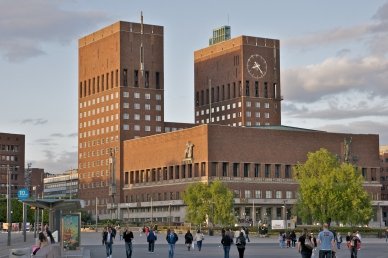
Oslo City Hall
The history of Scandinavia is impossible without the era of the Vikings, the courageous navigators who explored the North American coast long before Christopher Columbus. However, it was he who got all the credits for the discovery.
The Viking Ship Museum on the Bygdøy peninsula has existed since 1926. There are exhibited two ships and a prow used by the Vikings for burials. The displays also include the items traditionally put into the funeral ships for the warriors — sledges, carts, tents, and beds.
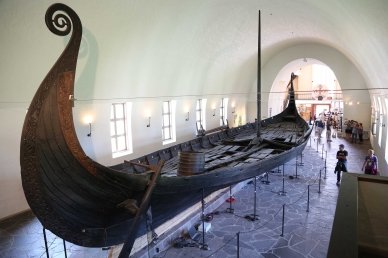
The Viking Ship Museum, Oslo
The Oslofjord
Called a fjord for some reason, this huge inlet with a hundred-kilometre coast has stretched from Norwegian south to north — to the very capital of this Scandinavian country.

The Oslofjord
By Norwegian standards, the Oslofjord coast is enormous. Around two million people live in numerous settlements within the internal islands. And that makes up approximately 50% of the entire population of the country. It is estimated that it takes nearly 45 minutes for more than one-third of Norwegians to get to the inlet coast.
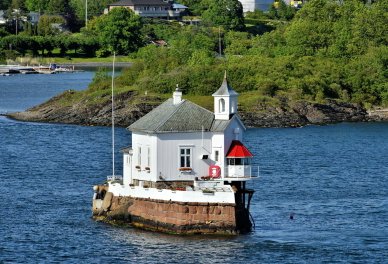
Dyna Light in Oslofjord near Oslo, Norway
The warmest climate in the country is here. Even in the middle of winter, in February, the average temperature is not higher than -2°C. And in summer, the temperature ranges from +17°C to +19°C.
For a good reason, the fjord is considered one of the brightest natural attractions of Norway. The inlet is surrounded by 1,700-m high mountains, the summits of which are covered with grey unmelting snows. The waterfalls with crystal clear waters are cascading there.
However, it is not only nature that lures tourists. There is the belief that the fjord opens the most breathtaking views of the Norwegian capital. Go for a boat ride around the inlet to get the overwhelming impressions. As a rule, the tours are organised right at the port near Grand Hotel. The tickets are available at the marina.
The ride usually takes three hours, so its price often includes a hot dinner.
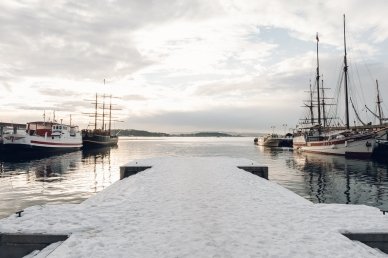
Cruise on the Oslofjord in winter, Oslo, Norway

Cruise on the Oslofjord in winter on a yacht

A view of Oslo during a cruise on the Oslofjord in winter
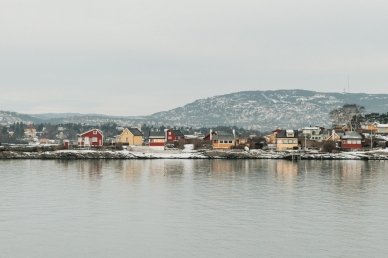
Colourful houses in the Oslofjord in winter
Food
Norwegian cuisine is simple, healthy, and nowadays is referred to as a superfood. Much fish, meat, milk, fermented dairy products, potatoes cooked in different variations, and coffee make the basis of the menu of an average Norwegian family.
They eat salmon, trout, cod, and herring, be it fried, roasted, salted, pickled, or even fermented.
Rakfisk (fermented trout) is a specific dish. The fish is put into a special brine in the barrels, where it starts to ferment and gets a very distinctive smell. In Sweden, they cook something similar but use herring instead of trout and call the dish surströmming.
Be it a Norwegian rakfisk or a Swedish surströmming, this food is merely for thrill-seekers or at least for gastronomical adventurers.
The smell that foreigners call the stink and the specific fish taste, which cannot be interrupted by any other food, make a brief description of this food event. Interestingly, nobody has had poisoning. The only problem is a weird aftertaste in the mouth and the necessity to brush teeth thoroughly and for a long time after eating. But eventually, you will be able to say: “Now I’ve seen it all.”
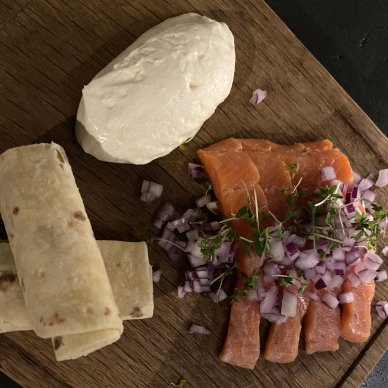
Rakfisk (fermented trout)
The other Norwegian delicacy is lutefisk — a fillet of dried cod soaked in lye for three days and later preserved in water.
This complicated manoeuver turns the fish pieces into a jelly-like substance that should be necessarily heated, either fried in a frying pan, roasted in an oven, boiled, or microwaved. In the end, there will be something with a very distinct and strong smell but a pretty pleasant taste. It is also a kind of exotic food as surströmming.
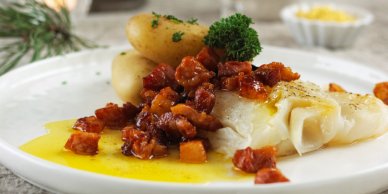
Norwegian Lutefisk
Lutefisk is served with garnishes — mashed potatoes or peas, local sorts of cheese (Brunost or goat cheese), Akvavit vodka, or beer. There is probably no other way of consuming it because the impressions left are too strong.
Anyway, that completes the list of gastronomical adventures. The other dishes of Norwegian cuisine resemble ordinary European food very much.
If you want to try meat, taste the game hunted in the dense Norwegian forests and cooked over the charcoals. It is usually served with various sauces, often the ones made of berries. The Norwegians are good at cooking mutton called smalahove and lamb ragout with vegetables called fårikål.

Norwegian fårikål
Coffee has not conquered the popularity rating of alcohol-free beverages in Norway. The number-one drink here is milk, consumed by people several times a day from their birth to a ripe old age without any restrictions and allergy to lactose. Coffee takes the second position.
In this harsh northern country, people love drinking alcohol. There is a belief that nobody can outdrink Norwegians, whose favourite drink is Akvavit — a potato-distilled vodka. There is another variety called Linje Akvavit. It is spilled in wooden barrels and sent on a long journey to the Australian coast. It is considered that during such a tour, vodka acquires a peculiar barrel aroma, for which linje has obtained its value.
Norway is the land that only at first glance might not fully correspond to general knowledge about a good rest. Indeed, you cannot take your ease at beaches or swim to your heart’s desire there, but the harsh beauty of nature in this country will touch you deep inside.
FAQ
What is the native name of Norway?
The native name of Norway is "Norge" in Bokmål and "Noreg" in Nynorsk.
What is the area of Norway?
Norway covers an area of approximately 385,207 square kilometers.
What is the capital of Norway?
The capital of Norway is Oslo.
What is Norway's population?
Norway's population is about 5.4 million people.
What language is mainly spoken in Norway?
The main language spoken in Norway is Norwegian, which has two written forms: Bokmål and Nynorsk.
What are the top 3 religions in Norway?
The top three religions in Norway are Christianity (predominantly Lutheranism), Islam, and Buddhism.
What is the official currency in Norway?
The official currency in Norway is the Norwegian Krone (NOK).
What type of government is Norway under?
Norway is a constitutional monarchy with a parliamentary system.
Does Norway have a good economy?
Norway has a strong, mixed economy with a high standard of living, supported largely by oil and gas exports, fishing, forestry, and mining.
What is Norway's biggest source of income?
Norway's biggest source of income is petroleum and natural gas production, with significant contributions from the service sector, shipping, and fishing.
Is Norway a member of the EU?
No, Norway is not a member of the European Union, but it is closely associated with the EU through its membership in the European Economic Area (EEA).
Is Norway a Schengen country?
Yes, Norway is a part of the Schengen Area.
For what is Norway famous for?
Norway is famous for its stunning natural landscapes, fjords, the Northern Lights, Viking history, and a high standard of living.
Is Norway friendly to tourists?
Yes, Norway is known for being tourist-friendly with well-developed infrastructure for travelers.
Who can go to Norway without a visa?
Citizens of EU/EEA countries and several other nations can enter Norway without a visa for short visits. The list of visa-exempt countries can change, so it's advisable to check current requirements.
Is it safe to go to Norway?
Norway is considered one of the safest countries in the world with very low crime rates.
Is Norway very expensive?
Norway is known for being one of the most expensive countries in the world in terms of living costs, dining, and accommodation.







